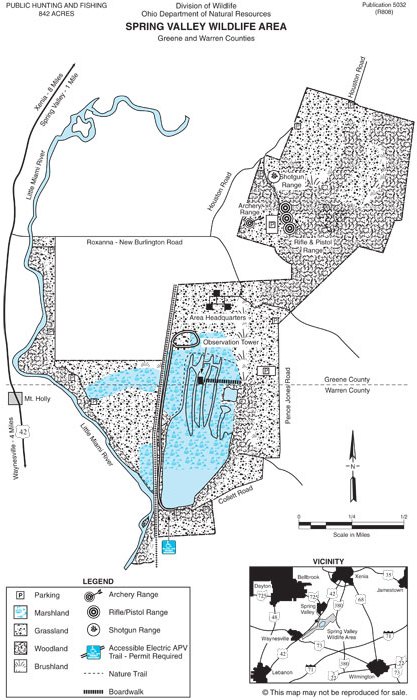Spring Valley Wildlife Area--South (Warren Co.)
Spring Valley Wildlife Area--South (Warren Co.)
Spring Valley, Ohio 45370
Spring Valley Wildlife Area Official WebsiteSpring Valley Wildlife Area map
Also, see all the hotspots at:
Little Miami River Important Bird Area
Birds of Interest
This location has diverse habitats for early migrant species such as kinglets, creepers, and sparrows. The waterfowl diversity during the spring migration can be great along with some early marsh birds beginning to sing such as Virginia Rails!
About this Location
Spring Valley extends into both Greene and Warren counties and is a favorite place to visit in March.
About Spring Valley Wildlife Area
See all hotspots at Spring Valley Wildlife Area
If you carefully keep your bird records by county, be sure to use the specific hotspots in this this wildlife area so that the birds will be assigned to the proper county. The north section of the wildlife area is in Greene County. The southern section is in Warren County.
Please note that the boardwalk at the Spring Valley Wildlife Area has been closed. There are no plans to repair and reopen it.
This 842-acre wildlife area is situated in the gently rolling agricultural region of southwest Ohio just east of the Little Miami River, eight miles south of Xenia, and four miles north of Waynesville. The area may be reached by turning east off US-42 onto Roxanna-New Burlington Road.
More than one-third of the area is in cropland and permanent meadow intermixed with brushy fence rows and extensive brushy coverts. Woods cover approximately a third of the area. A 150-acre lake and marsh complex are located on the area’s south edge.
Purchasing of land for this public hunting and fishing area began in 1953. The area includes the old Sinclair Fur Farm lake and marsh which was improved in 1954 to provide the present 80-acre lake. In addition to hunting and fishing, secondary uses, such as gun and archery target shooting and wildlife observation, have become increasingly important.
Cropland is managed to provide a good distribution of wildlife food and cover in conjunction with the permanent meadow and woody cover. More than 100,000 trees and shrubs have been planted to provide permanent wildlife cover.
Features
Restrooms on site
Wheelchair accessible trail
Entrance fee
Roadside viewing
Content from Spring Valley Wildlife Area Official Website, Tyler Ficker, Ohio Ornithological Society Southwest Regional Director, and Ohio Ornithological Society
Last updated February 13, 2023
